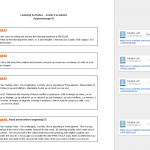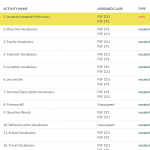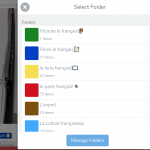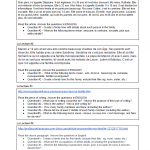I used information and communication technology (ICT) to enhance the teaching and learning in my French as a Second Language (FSL) classrooms. I used programs specific to and unrelated to French language instruction and designed classroom specific challenges for the students to work on their oral communication skills and written skills. While students were independently involved in self-directed learning, I was able to provide small group instruction to further the learning of students. Small group instruction, as well as the learning portfolio students used online, allowed for more quality assessment for/as learning. The use of technology also allowed students to differentiate their learning which created a more engaging learning environment.
I then used what I had been working on to inspire and begin conversation with other FSL secondary teachers in our board regarding the deeper learning that could occur if technology was used in ways other than for just knowledge-seeking information or as a French-English dictionary.
Team Members
Tabatha Luft
Renfrew County District School Board
Cheryl Welbanks
Renfrew County District School Board
Professional Learning Goals
- Increased the use of technology programs as a teaching tool in the classroom
- Increased the use of technology programs for assessment of/for/as learning
- Provided greater opportunity for triangulation of evidence
- Increased the opportunities for differentiated instruction and student-centred learning
Activities and Resources
I first created an information sheet for students to use as a reference for guiding their tasks during the independent structured learning time. During this designed classroom time, students would work independently on activities (see below for activities) and place evidence of their learning or understanding in their Seesaw Learning Portfolio (an online tool for students to view their ongoing work).
Technology activities included:
Use of Google Read and Write
- Students could listen to the pronunciation of vocabulary and also record themselves pronouncing the vocabulary listed on their reference sheet (I could access their recordings later to provide feedback)
- Students could listen to pre-recorded dialogue and then answer comprehension questions (students were given the answers and could self-assess whether they understood the dialogue and reflected on the listening strategies they used to be successful)
- Students could access links to reading activities chosen for them and then answer comprehension questions (students were given the answers and could self-assess whether they understood the dialogue and reflected on the listening strategies they used to be successful)
Use of Duolingo (www.duolingo.com)
- I used this program and created a classroom within the program
- The program is designed to learn second languages
- Students were quite engaged with this program and acquired additional vocabulary, as well as common everyday phrases
- This program incorporated listening, speaking, reading and writing
- Often I set a goal of completing up to a certain activity by a certain date so that students would have common vocabulary knowledge to continue with classroom activities
Use of Conjuguemos (Conjuguemos.com)
- I created a classroom for this site
- I then created activities and vocabulary lists specific to our classroom learning
- Students used this site to learn vocabulary
- It also has the potential to learn sentence structure and grammar points, although I have not incorporated that part as of yet
Use of Seesaw (https://web.seesaw.me/)
- This was their learning portfolio
- Students completed activities of their learning into their account for me to provide feedback. The feedback was often a back and forth dialogue between myself and the student.
- Students could access notes
- Students could ask questions of clarification from the lessons
- Parents became partners and could access their child’s portfolio and also comment on the work the student was incorporating
Use of BonPatron.com
- This site allowed students to work on their writing process. Particularly, it played an important role in self-correcting their work.
- The site highlights errors in their written work and provides a grammatical explanation of the error but does not correct it for the student. The student used their understanding of the explanation to fix the errors.
Use of Google Classroom
- Students could see a daily recap of each lesson
- Students could access videos used in class for learning, as well as any homework assigned. Students who were absent found this very useful.
- Parents were able to have access to this as well. This allowed parents to be partners in their child’s learning and be informed about what was going on in the classroom.
There were some other programs I used, such as fluency tutor and Idéllo, but I shortly stopped using them as I had not planned out that part well enough for the students to be successful for using it to advance their French skills.
While students worked independently, I called upon small groups of students to do small group instruction. The small groups were determined using their learning portfolios as an informative tool for assessing where students were in their learning, where gaps lied and where the students needed to go. Grouping of students always varied and the information discussed and learned was specific to the needs of the students at the time. Activities would include: speaking interaction skills, increasing vocabulary, reflection, instruction or re-instruction of grammar structures, writing skills, reading activities to improve comprehension by reinforcing the use of reading strategies or listening activities using and reinforcing listening strategies, anything to move the students learning forward.
In addition, the equipment purchased and used for technology were:
- Chromebooks
- Headsets with microphones
- Partial contribution for a cart to hold the Chromebooks and be able to charge them (my principal provided the remainder of the funds)
Unexpected Challenges
Challenge #1 – The Release of Learning to the Students
My biggest challenge was the gradual release of learning to students. I had the opportunity to try my activities out with four separate classes. We are a semestered school, so two classes were from September to January and the other two were from February until June (still ongoing). The first semester classes I modelled what independent work time looked like and spent much time at the beginning of the course setting out the expectations of behaviour during independent learning and reinforced it for weeks before really doing meaningful work in the small group instruction. Having done this, the students worked effortlessly and efficiently during the independent learning time for the remainder of the semester. At the beginning to beginning of the second semester, I released the learning too early and with not enough modelling for students to be as productive as they could have been.
Challenge #2 – Connectivity Issues
I have experienced untimely connectivity issues, often in the middle of class where students would lose work and become frustrated. I did try and work through this as best I could by extending deadlines and allowing students to submit work for feedback in other formats.
Challenge #3 – Quantity of Assessment
Students were submitting a lot of work for assessment which created an abundance of work in the evenings for me, and subsequently I couldn’t catch up with all the submissions to look at. Students accessed their learning portfolio outside of class hours and kept submitting work. I eventually had to decide not to provide feedback on everything they placed in their portfolio and only chose a set number of activities to provide feedback on, making sure to connect with everyone at least twice a week on something they submitted.
Enhancing Student Learning and Development
This project allowed me to conference with students more, knowing that the other students were engaged in their learning. Students received more quality feedback and the opportunity to work with me in small groups. The smaller group instruction seemed to help students ask more questions about their learning and clarify their understanding – they were not as shy in this type of setting to reflect and inquire about their learning. The technology allowed for students to gain feedback on their speaking skills with the help of a computer for pronunciation purposes, which in turn advanced their ability to communicate effectively in FSL so they didn’t need me as much to help in this area – or at least had a tool to learn when I was occupied with other students. The technology also allowed them practice time to sharpen their knowledge of vocabulary and grammar structures. This independent access to learning truly showed when we then worked on oral communication skill and interaction skills as whole group instruction. Because students had worked independently on learning vocabulary and deepening their understanding of the grammar, students could then spend more time as a whole group that focused on interaction – the application of the knowledge and understanding.
Sharing
I have shared my project in the following ways:
I met with our boards elementary teacher in the family of school for our area. I discussed my project and they were very interested. Some have incorporated some of the programs I was using to enhance the teaching and learning in their classrooms.
I met with our board’s secondary FSL teachers on three occasions. The first meeting (October 2016), I explained my project which generated curiosity and interest. The second meeting (December 2016), all the secondary FSL teachers, the curriculum co-ordinator and the elementary FSL specialist came to observe my classroom in action. We then debriefed, where I was provided feedback and answered questions. From this, one teacher has found funds to increase the technology in her classroom and we have been working collaboratively to increase her use of technology in the classroom. Two other teachers have also incorporated some of the programs I was using into their regular practice. On the third meeting (March 2016), I recapped how my project was going, changes I had made and challenges I have faced. We also brainstormed next steps for me for my use of technology.
Project Evaluation
I would say my project was a success!
I determined it was success in two ways: (1) observation of the learning environment – there was an engagement in their learning that I had not seen before and (2) the increase in use and the comfortability of the use of the FSL was extremely evident when we worked on interaction skills – the students had a base to work from and were able to focus on the application of the language. I have rarely gotten to this point in my courses during a semester, but this year I spent the bulk of the teaching being able to work with students in applying the language. In addition, this was an evaluation year for me. My principal was able to assess my use of technology and student engagement and he was very complimentary in respect to the level of engagement he observed during his observation visits.
As I continue on my learning journey, I will probably decrease the programs used for rote memory of vocabulary (yet allow students access for extra support) and use it more for inquiry-based tasks of the language so that we can continue to focus the bulk of our time on applying the language in authentic-speaking activities that promote interaction, although it has developed from my initial planned out process due to ongoing reflection throughout the year. I definitely used more technology in the classroom than ever before and used it well beyond the use of knowledge-seeking and French-English dictionary purposes! The use of an online learning portfolio (Seesaw) allowed me to accomplish my goal of quality assessment of/for learning as did the small group group instruction which the use of technology allowed me to do effectively. Due to students being engaged in meaningful learning activities with technology, I was able to conference with students, observe students, and use their completed tasks to triangulate evidence of learning and guide their next steps in their learning journey and differentiate the learning. Most of all, which I am the most excited about, students began to be independent self-directed learners who are reflective in their learning.
Resources Used
Resources: Chromebooks, headsets with microphones, iPads (already in the classroom)
Technological Programs:
https://web.seesaw.me/
www.bonpatron.com
Google Read and Write
www.conguguemos.com
www.duolingo.com
Resources Created
These resources will open in your browser in a new tab, or be downloaded to your computer.





